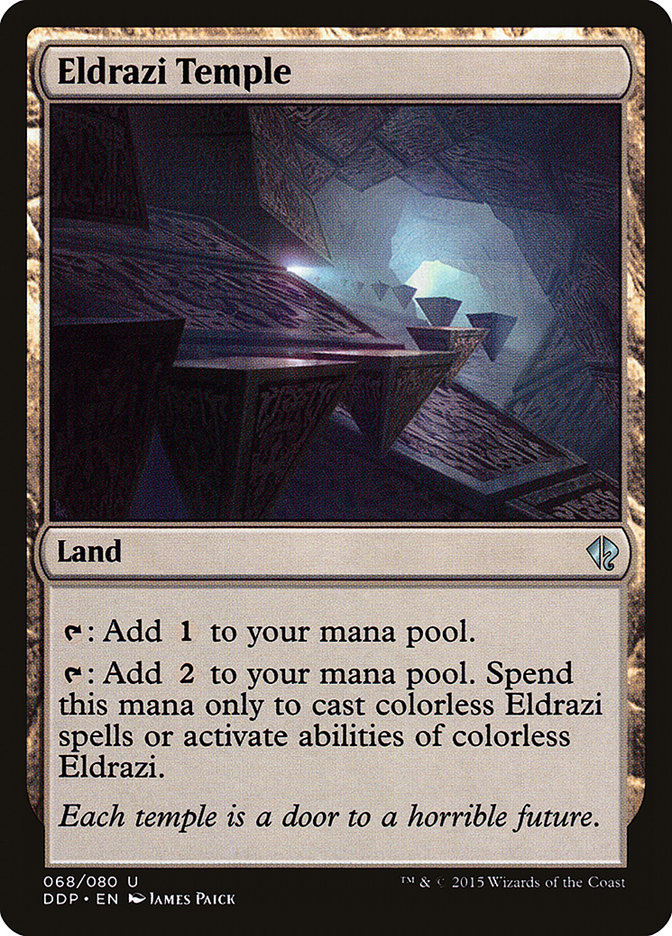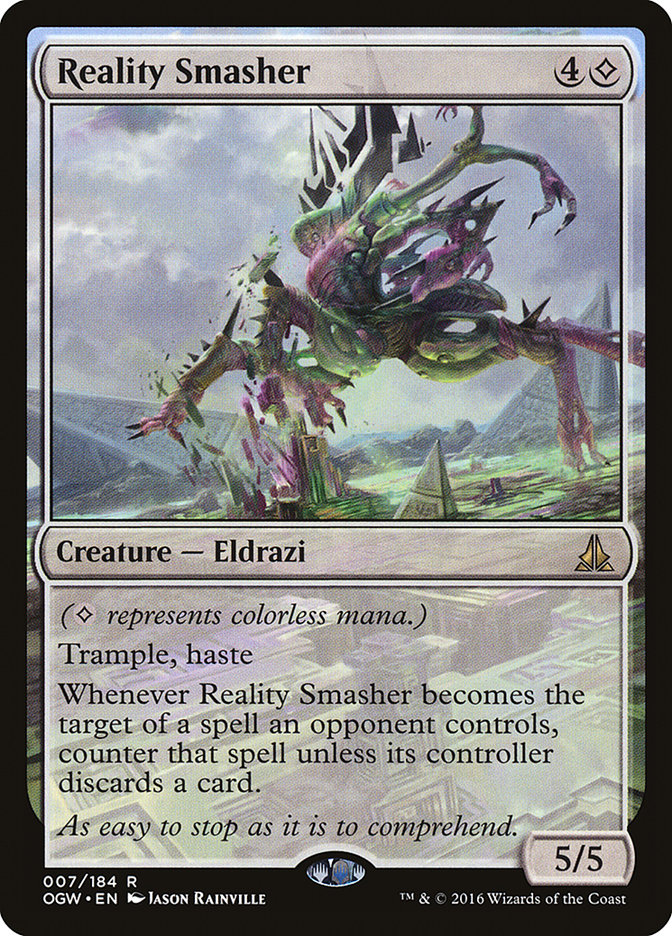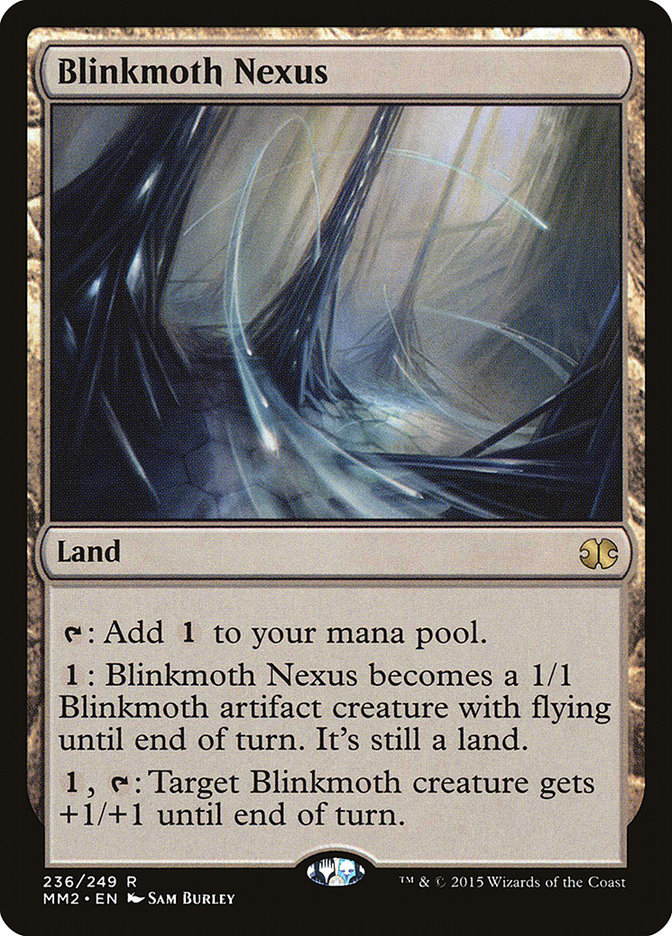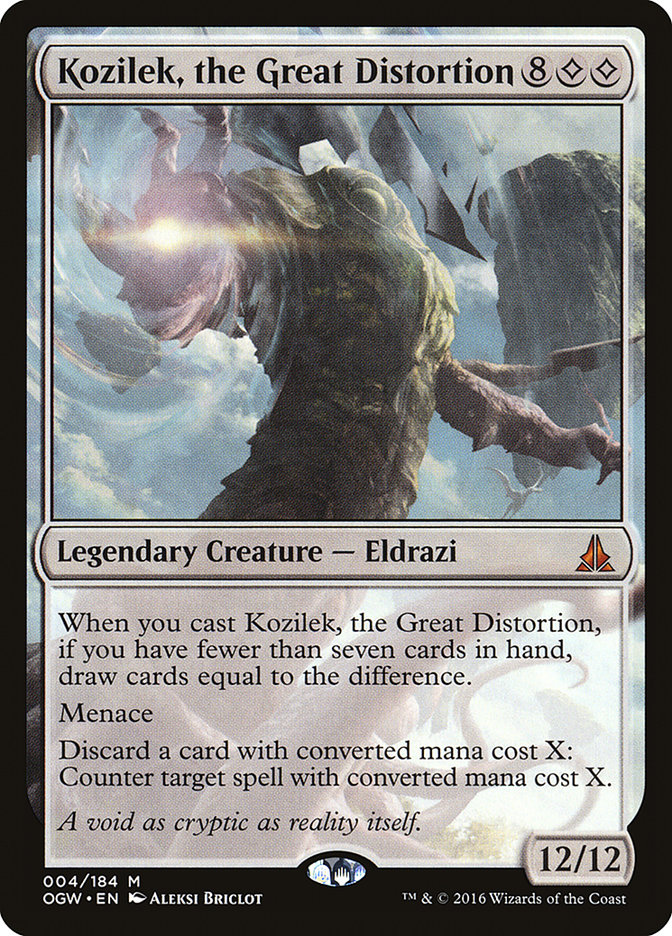They’re back!
Eldrazi Winter may have ended when Eye of Ugin was banned in April, but a deck as powerful as Modern Eldrazi can’t be kept down that easily. Recent Magic Online results from competitive Modern Leagues suggest that there are a number of Eldrazi shells built around a common core of Eldrazi Temple, Matter Reshaper, Thought-Knot Seer, and Reality Smasher. Today we’ll examine the three most successful builds and try to figure out what makes them resilient enough to stick around and get good results, even after a key card was banned from the archetype.
Bant Eldrazi
During the weeks after the Eye of Ugin ban, plenty of people who still loved curving Thought-Knot Seer into Reality Smasher tried to figure out how to keep the spaghetti monsters going in Modern. Some people turned to a R/G Eldrazi deck that used artifact-based ramp spells, but that was quickly replaced by the much more successful Bant Eldrazi deck. Not only did Kozilek’s Return turn out to be unimportant for the archetype, missing out on the insane synergy between Eldrazi Displacer and Drowner of Hope was just too much.
The Eye-less Bant Eldrazi deck was tuned and popularized by Gerry Thompson, Michael Majors, and Todd Stevens, who proved that a competitive Eldrazi deck could survive the bannings by taking a more traditional approach to Modern: ramp, cantrips, and removal. After plenty of camera time and an eleventh place finish from Todd Stevens at #SCGINDY, the public realized that Eldrazi still lives in Modern.
Creatures (28)
- 1 Birds of Paradise
- 4 Noble Hierarch
- 3 Spellskite
- 4 Drowner of Hope
- 4 Eldrazi Displacer
- 4 Reality Smasher
- 4 Thought-Knot Seer
- 4 Matter Reshaper
Lands (21)
Spells (11)

Because of the requirement for colorless mana, this deck is nearly a four-color deck, and one of its “colors” can’t come from the traditional fetchland and shockland manabase of Modern. However, the inclusion of Birds of Paradise and Noble Hierarch significantly helps that problem. By focusing the manabase on a base of green, you’re more likely to get the rest of the colors thanks to the early ramp creatures as well as Ancient Stirrings.
Instead of the much more aggressive Colorless Eldrazi build from #PTOGW, this deck takes a more midrange approach, leaving out Eldrazi Mimic and Endless One. Instead, it goes all the way up to World Breaker at the very top of the curve with the Eldrazi Displacer / Drowner of Hope engine along the way. The repeated ability to blink your Drowner of Hope to generate Scions for attacking, blocking, or tapping enemy creatures is just insane value and is part of the power level of this deck.
Being Bant gives the deck a lot of flexibility and choices during deckbuilding. While the deck doesn’t run too many ways to grow Tarmogoyf, opponents in Modern often do it for you, so some Bant Eldrazi decks run the efficient beater. Eldrazi Skyspawner is another great option for an early creature, since it’s a flying creature that comes with an Eldrazi Scion and benefits from Eldrazi Temple. Noble Hierarch also provides additional value over the Colorless Eldrazi build, as her exalted ability can help your Reality Smashers attack for six or seven damage.
Here’s an example of another recently successful build that shares the same core but exercises some different choices in its flex slots.
Creatures (28)
- 4 Tarmogoyf
- 4 Noble Hierarch
- 4 Drowner of Hope
- 4 Eldrazi Skyspawner
- 1 World Breaker
- 3 Eldrazi Displacer
- 4 Reality Smasher
- 4 Thought-Knot Seer
Lands (21)
Spells (11)

Many people call white the best sideboard color in Modern, and Bant Eldrazi takes full advantage of that. This deck has access to everything from Fracturing Gust for Affinity, to Rest in Peace for graveyard decks, to Worship and Timely Reinforcements for aggressive creature decks. The Grafdigger’s Cages are a nod to the deck’s weakness to Abzan Company, while a bit of countermagic in the form of Negate and Stubborn Denial helps against spell-based combo decks.
This seems to be the most popular version of Eldrazi that still exists in Modern, but is it the only viable option? Recent Magic Online results suggest there are other builds out there waiting to be optimized, ready to take down tournaments.
Colorless Eldrazi
One of the most successful builds of Modern Eldrazi at #PTOGW was Team CFB’s Colorless Eldrazi. This deck was built to abuse the interaction of Eye of Ugin with the low-cost Eldrazi printed in Oath of the Gatewatch while preparing for an aggressive metagame in the form of full playsets of Dismember and Chalice of the Void powered out on turn 1 by Simian Spirit Guide. Given the prevalence of Death’s Shadow Aggro and Infect during #PTOGW, it had great success, losing to the mirror-breaking U/R Eldrazi in the finals!
Now we’re back to a Modern metagame dominated by fast decks such as Death’s Shadow Aggro, Infect, Zoo, and Dredge on Magic Online. Player Contrap decided to revive the deck that was built to beat fast aggro just like that at the Pro Tour!
Creatures (26)
- 4 Simian Spirit Guide
- 2 Spellskite
- 4 Endless One
- 4 Eldrazi Mimic
- 4 Reality Smasher
- 4 Thought-Knot Seer
- 4 Matter Reshaper
Lands (24)
Spells (10)

Without Eye of Ugin in the Modern format, Colorless Eldrazi doesn’t have the insane starts it used to with Eye of Ugin, Eldrazi Mimic, Eldrazi Mimic, Eldrazi Mimic on turn 1 into Eldrazi Temple, Simian Spirit Guide, Reality Smasher, attack for lethal on turn 2. However, that doesn’t stop this aggressive take on Eldrazi from being a powerful option. The curve stays fairly low compared to Bant Eldrazi and Eldrazi Tron, topping out at five mana for Reality Smasher.
This deck keeps the Pro Tour strategy of deploying an early Chalice of the Void thanks to Simian Spirit Guide and mopping up tokens and aggressive creatures with Ratchet Bomb. These strategies help buy the time that was lost to the banning of Eye of Ugin. Stealing Game 1 thanks to these powerful hate cards leads to a much easier time picking up the match. The addition of Matter Reshaper gives a bit of card advantage and ramp while protecting against more aggressive strategies in the early game.
The inclusion of creature-lands like Mutavault and Blinkmoth Nexus is possible thanks to the complete lack of need for color-producing lands, so once your hand is empty, you can stop casting spells and start beating up your opponent with your manabase. Eye of Ugin’s slots are taken up by Sea Gate Wreckage, another land that gets better once your hand is empty, and Desert to help stem the bleeding against super-fast aggro decks like Affinity.
One interesting carry-over from the Pro Tour decklists is Urborg, Tomb of Yawgmoth. This used to be used in combination with Eye of Ugin so that the Eye would tap for mana thanks to also being a Swamp. However, the only benefit I see Urborg providing now is reducing the amount of damage from Dismember. While extra life can certainly help against the very same aggressive decks you need Dismember for the most, you usually won’t have time to pay extra mana for the card anyway. I wonder if the inclusion of Cavern of Souls or even Dread Statuary would be better in that slot.
From the sideboard, we see a strategy that hearkens all the way back to before the release of Oath of the Gatewatch, when the best thing to do with the broken Eldrazi lands was to play Relic of Progenitus and Blight Herder. As it turns out, this is still a powerful strategy against midrange decks like Jund while providing additional splash hate against graveyard-focused decks.
Eldrazi Tron
The other alternative to staying colorless is to go bigger. If you decide to spice up your manabase with bigger numbers (Urza’s Tower) instead of the ability to become creatures (Mutavault), casting Ulamog, the Ceaseless Hunger becomes a real possibility.
This strategy was pioneered by Zach Voss and his St. Louis team, who made the finals of #SCGRegionals on the same day #PTOGW revealed Team CFB’s Colorless Eldrazi build. I actually had the pleasure of testing against this deck in the weeks before the Pro Tour, as it began to dominate the Friday Night Magic events at my local game store. He went on to miss Top 8 at #SCGLOU on tiebreakers with the deck, a heart-breakingly close result.
The eventual loss of Eye of Ugin meant there was room for innovation, though, and Eldrazi Tron has begun to show up again, this time tuned for an Eye-less mana curve. Eldrazi Mimic and Endless One have been dropped, replaced by Spellskite and the very spicy Endbringer.
Creatures (22)
- 3 Spellskite
- 2 Ulamog, the Ceaseless Hunger
- 1 Kozilek, the Great Distortion
- 4 Endbringer
- 4 Reality Smasher
- 4 Thought-Knot Seer
- 4 Matter Reshaper
Lands (24)
Spells (14)
Sideboard

Unlike R/G Tron, Eldrazi Tron does not spend its entire early game finding and assembling the “Urza Tron,” the combination of Urza’s Tower, Urza’s Mine, and Urza’s Power Plant. Instead, just four copies of Expedition Map and a bit of luck are used, meaning there’s plenty of room below seven mana to include the powerful Eldrazi core. The addition of Spellskite gives the deck a great early blocker, a hoser for decks like Infect and Hexproof, and in the late-game a way to protect your more expensive creatures.
And at the top end, who doesn’t love casting Ulamog, the Ceaseless Hunger? This three-for-one gets the benefits of Urza lands and Eldrazi Temple, meaning it’s not uncommon for this to come down on turn 5 and practically end the game on the spot. This version of Modern Eldrazi also leaves room for a copy of the other Eldrazi titan that was ravaging Zendikar, Kozilek, the Great Distortion. Because it has cards at every mana cost from zero to six, the odds are that Kozilek’s Force of Will-like ability will actually matter while you beat down with a 12/12 menace.
Chalice of the Void remains in the maindeck; without Simian Spirit Guide to power it out early, though, it goes back to just being “great” instead of “insane.” The inclusion of Warping Wail and Dismember provide a bit of interaction, and Endbringer’s flexible abilities mean this deck doesn’t mind going long.
However, like many Tron decks, Eldrazi Tron suffers against extremely aggressive decks. The sideboard is stocked full of answers for quick decks, all the way up to All Is Dust as a one-sided sweeper. Basilisk Collar isn’t just great against aggressive decks because of the lifelink, though. Equipping the Collar to an Endbringer means you can begin picking off two creatures per turn thanks to the deathtouch.
Conclusion
Even with Eye of Ugin banned, there’s still a great Eldrazi archetype to be played. It might be Bant, Colorless, or Tron, or it might be another shell entirely. Or maybe Eldrazi is an archetype best played flexibly, adapting as the metagame shifts. Bant Eldrazi is strong in a midrange-heavy metagame, thanks to recursive threats like World Breaker. Colorless Eldrazi can race with the best of them, staying quick in an aggressive metagame full of Death’s Shadow Aggro and Infect. And Eldrazi Tron loves going into the late-game, shining in a metagame full of control decks.
Tuning a deck to find its best iteration for a given metagame is a puzzle pro teams like Team Metagame Gurus, Team Cardhoarder, and Team Bolas love to solve, but iteration through published decklists and open discussions can bring that same tuning to everybody! What have your recent experiences been with Eldrazi in Modern? Have you played with or against another version of Eldrazi we didn’t cover here? I’d love to hear more about it!
Have a wonderful week, and as always: happy gaming!








